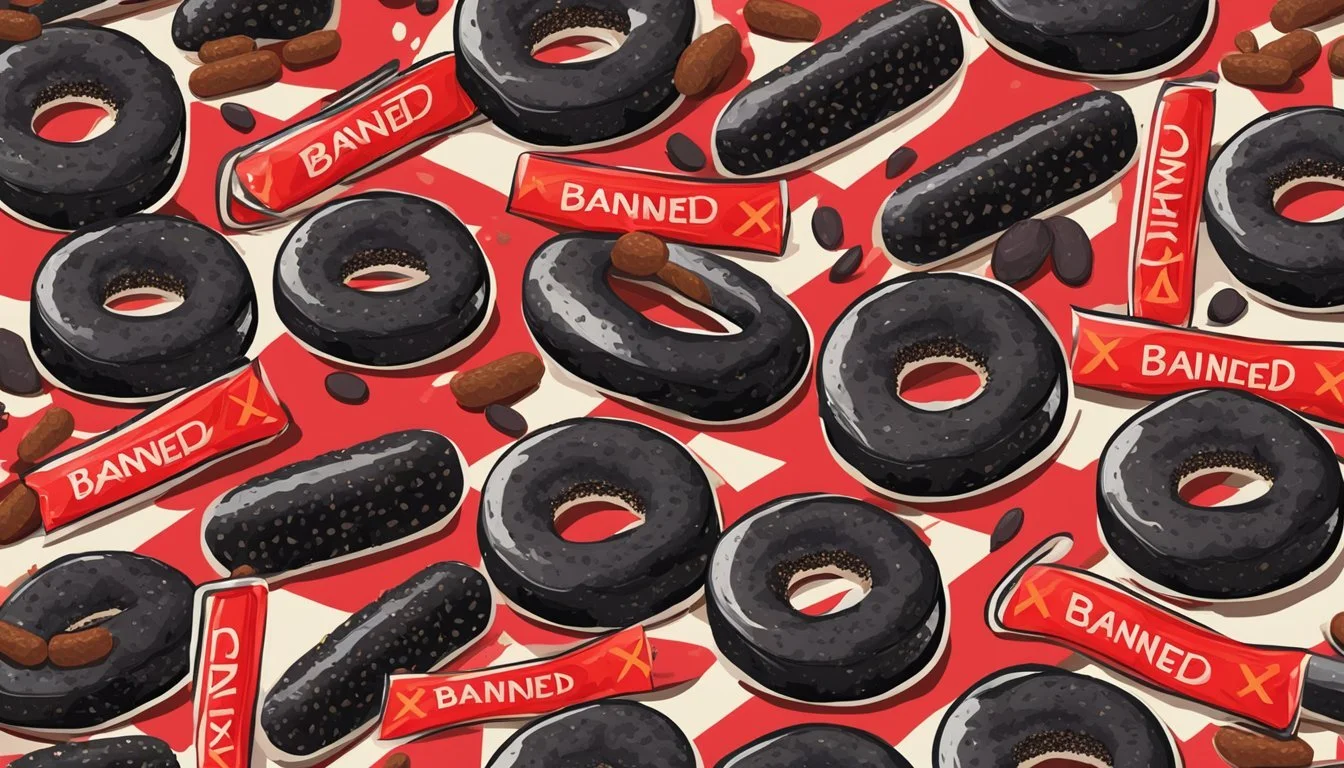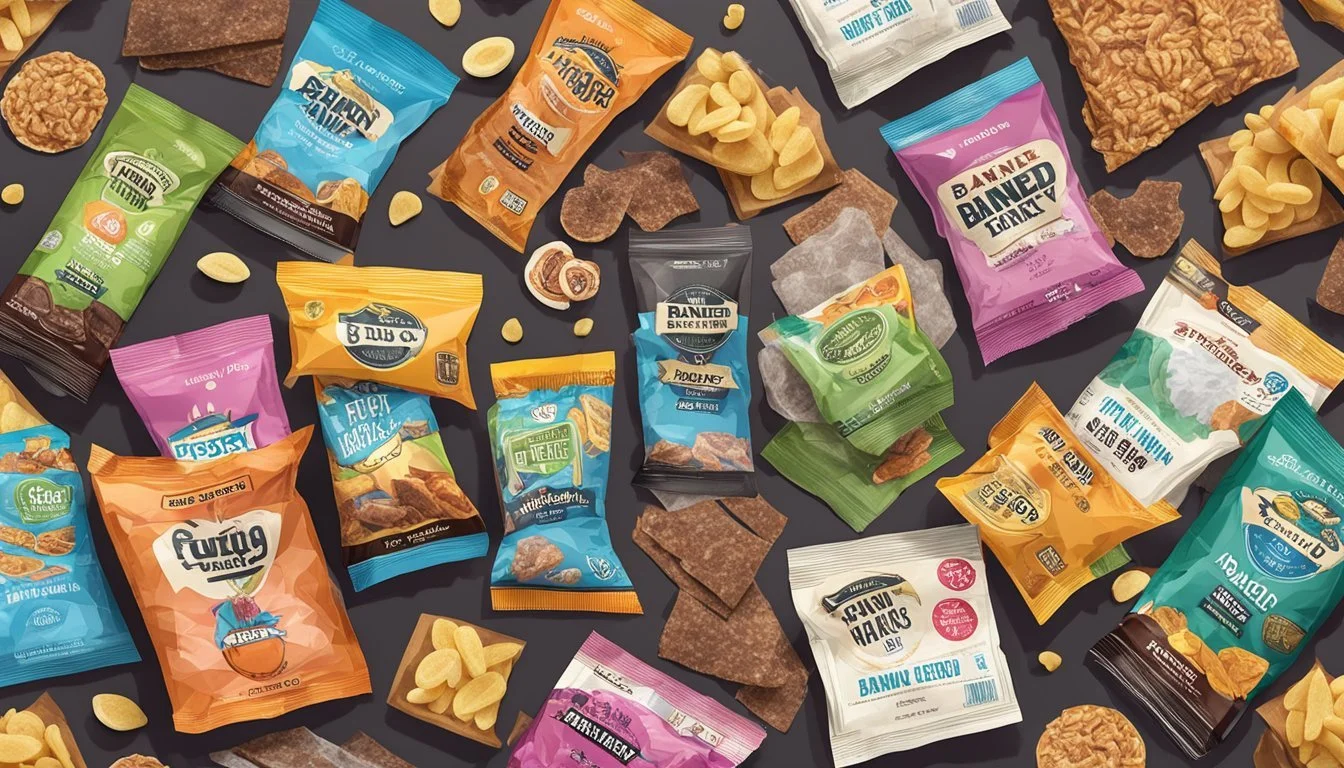10 Banned Snacks
Controversial Treats from Around the World
Across the globe, several beloved snacks have been targeted for bans due to their controversial ingredients and potential health risks. From savory tidbits to sweet treats, these prohibitions reflect growing concerns over food safety and nutritional standards in different countries.
What makes a seemingly harmless snack face a ban, and why do some nations take a stand against these popular items? Understanding the reasons behind these bans can offer insights into the varied regulatory landscapes and public health priorities worldwide, sparking a conversation about what goes into the foods we often enjoy.
1) Kinder Surprise
Kinder Surprise is a chocolate egg that contains a toy hidden inside a plastic capsule. Although their unique combination of candy and toy has made them popular worldwide, they are banned in the United States.
The primary reason for the ban is due to safety concerns. Specifically, the FDA prohibits the inclusion of non-nutritive objects inside food items because of the risk of choking, particularly among children.
The origins of this regulation date back to a 1930s law designed to prevent potential choking hazards. The toy, enclosed within the chocolate shell, is considered a violation of this law, which aims to separate food and non-food items clearly.
Efforts have been made to develop a version suitable for the U.S. market. Despite this, traditional Kinder Surprise eggs remain unavailable for sale in the country.
This ban has generated significant debate over consumer safety versus consumer choice, sparking both criticism and support. While Kinder Surprise is readily available in many other countries, its status in the U.S. remains unchanged due to the existing regulations.
2) Haggis Chips
Haggis chips are banned in the United States. These chips, inspired by the traditional Scottish dish haggis, offer a unique flavor that combines meat, spices, and oats.
In Scotland, haggis is a beloved dish. It's made from sheep's heart, liver, and lungs, mixed with onions, oatmeal, and spices, then encased in the animal's stomach.
The ban on haggis chips stems from the same regulations that prohibit traditional haggis. Specifically, U.S. law forbids the consumption of livestock lungs. This is due to concerns about fluid contamination during the slaughtering process.
Despite the ban, haggis chips remain popular in other parts of the world. They capture the distinctive haggis flavor in a crunchy, snackable form.
In the U.S., food enthusiasts often express regret about the ban, noting that it prevents people from experiencing a taste of Scottish culture. The prohibition remains enforced due to the strict laws on livestock lungs.
3) Sichuan Peppercorns
Sichuan peppercorns, a key ingredient in many Chinese dishes, were banned in the United States from 1968 to 2005.
The restriction was imposed by the USDA to prevent the spread of citrus canker, a bacterial disease that affects citrus plants.
These peppercorns are not true peppers but are the dried husks of the berries from the prickly ash shrub.
During the ban, only heat-treated peppercorns could be imported to ensure they did not carry the bacterium.
This made obtaining authentic, high-quality Sichuan peppercorns difficult for many years.
The ban was lifted after it was determined that heat treatment effectively eliminated the risk of citrus canker.
Sichuan peppercorns provide a unique numbing sensation and flavor profile that is crucial to dishes like kung pao chicken and mapo tofu.
Despite the lifting of the ban, the quality and potency of Sichuan peppercorns available in the U.S. still vary.
4) Absinthe Gummies
Absinthe Gummies, a novelty candy, draw attention due to their connection with the well-known alcoholic beverage, absinthe. Absinthe itself, often linked to artistic inspiration and health concerns, must adhere to strict regulations regarding its thujone content.
The hallucinogenic reputation of absinthe is largely historical. Modern regulations ensure that any absinthe-based product, including gummies, is safe for consumption by keeping thujone levels low.
The legality of absinthe in the United States has influenced the availability of Absinthe Gummies. Following the removal of the absinthe ban, products derived from or inspired by absinthe have surfaced, provided they meet FDA guidelines.
Though Absinthe Gummies might seem harmless as a candy, their association with alcohol and the psychoactive myths of absinthe make them controversial. This can lead to stricter scrutiny and potential bans in various regions.
Apart from regulatory issues, Absinthe Gummies also face criticism for promoting alcohol-themed products to younger audiences. Parents and educators often voice concerns about the message such candies send to children.
While they might appeal to adventurous adults, the combination of candy and absinthe remains a contentious and closely monitored topic.
5) Black Pudding Snack Sticks
Black Pudding Snack Sticks have faced bans in certain regions, primarily due to their ingredients and preparation methods. Black pudding is a type of blood sausage made from pork or beef blood, fat, and oatmeal.
The primary concern is the use of blood in food products, which has led to stringent regulations in some countries.
Additionally, some consumers find the concept of eating blood-based products unappealing, contributing to decreased demand and subsequent bans. Despite this, black pudding has a rich history in various cuisines and remains popular in regions like the UK and Ireland.
Its nutritional content is also notable, providing high iron levels, protein, and other essential nutrients.
Regulatory bodies enforce bans to prevent possible health risks associated with blood consumption and to maintain certain cultural or ethical standards. This has led to black pudding snack sticks being unavailable in specific areas.
6) Raw Milk Cheese
Raw milk cheese has been a topic of debate in the United States for years. The FDA mandates that raw milk cheese must be aged for at least 60 days to ensure safety. This regulation stems from concerns about pathogens that can thrive in unpasteurized milk.
Notably, certain types of raw milk cheese remain prohibited. For instance, in November 2023, the FDA added Morbier to the ban list due to its line of ash, which was deemed unsafe. Other cheeses like Azeitão, a traditional Portuguese cheese, also face restrictions because they are made from raw sheep's milk.
The aging requirement of 60 days aims to reduce the risk of harmful bacteria such as Listeria and Salmonella. While raw milk cheese lovers praise its rich flavors, its safety remains a concern for health authorities.
Moreover, legal raw milk cheese must be stored at temperatures below 36 degrees Fahrenheit. This strict temperature control is another measure to prevent bacterial growth.
Despite these regulations, raw milk cheese is popular in many parts of the world. However, in the U.S., strict rules and certain bans aim to protect public health.
7) Bacon Marmalade
Bacon marmalade, a savory and sweet condiment, has gained popularity for its rich flavor profile.
Ingredients typically include bacon, onions, brown sugar, and sometimes coffee or bourbon for depth. These elements are cooked together until they achieve a thick, jam-like consistency.
The preparation begins with cooking the bacon until crispy and removing it from the pan. Onions are then caramelized in the bacon drippings, blending with the sugar and other liquids. This process allows the flavors to meld into a cohesive spread.
Bacon marmalade can be used in various ways, such as on burgers, sandwiches, or even as a dip for appetizers. It provides a unique combination of sweet and salty elements that can enhance a wide range of dishes.
This savory jam has its origins in innovative kitchens seeking to elevate the traditional uses of bacon and onions. It reflects a trend in culinary arts where classic ingredients are transformed into novel and versatile treats.
Its ban can often be linked to health concerns associated with processed meats and high sugar content. Despite this, bacon marmalade remains a beloved and intriguing delicacy among those who savor its unique taste.
8) Fugu Jerky
Fugu jerky is derived from the meat of the Japanese pufferfish, known scientifically as Takifugu. This delicacy carries a risky reputation due to the presence of tetrodotoxin, a potent neurotoxin.
The preparation of fugu jerky involves dehydrating and seasoning the fish meat. This process can intensify its unique flavors, making it a sought-after snack, albeit controversial.
Highly skilled chefs, often with years of training, are required to prepare fugu safely. Improper handling can lead to poisoning, making it illegal in many countries without proper authorization.
Despite the risks, enthusiasts claim that fugu jerky offers an unparalleled taste experience. This has led to a persistent demand in regions where it remains legal.
Fugu meat, when made into jerky, retains a chewy texture and slightly sweet taste. The jerky is often enjoyed as a gourmet item, reflective of Japan’s intricate culinary traditions.
Caution is paramount when consuming fugu products. Only purchase from reputable sources to mitigate the dangers associated with this banned snack. The allure of forbidden flavors continues to fascinate adventurous eaters.
9) Horse Meat Jerky
Horse meat jerky is a controversial snack that has faced significant opposition in several countries, including the United States.
In the U.S., horse meat is legal to consume but not easy to obtain. The federal government prohibits the sale and shipment of horse meat without inspection, and no legal process for inspection currently exists. Cultural values and federal legislation strongly oppose horse meat production.
Countries like France have a long history of horse meat consumption. Historical edicts, such as one from Pope Gregory III in 873 AD, have influenced its acceptability. Yet, horse meat remains a relatively rare delicacy and has faced numerous bans over centuries.
In Europe, horse meat has been used as a substitute for other meats in many recipes due to its lean quality. Regulations in places allow for the slaughter of horses, often involving young animals between 16 to 24 months old.
Despite existing legal pathways for consumption in some areas, ethical concerns and stringent regulations keep horse meat jerky out of popular circulation in many regions.
10) Jellied Eels
Jellied eels are a traditional English dish that originated in the 18th century, primarily in the East End of London. This delicacy consists of chopped eels boiled in a spiced stock that is allowed to cool and set, forming a jelly.
First enjoyed by London’s working class, jellied eels became popular due to their low cost and high nutritional value. They are usually served cold and are often paired with pie and mash.
Despite their historic popularity, jellied eels have become less common in modern times. Their unique texture and flavor can be off-putting to some, leading to their reputation as a "love it or hate it" dish.
In some places, concerns about overfishing and the sustainability of eel populations have led to restrictions on eel fishing, indirectly impacting the availability of jellied eels. This has made the traditional dish less accessible and more rare.
As other snacks face bans due to health concerns, jellied eels stand out as a product affected by environmental regulations and changing tastes rather than direct legislative action. The cultural significance of jellied eels remains, even as their presence diminishes.
Health Risks of Consuming Banned Snacks
Banned snacks possess several health risks, including harmful additives linked to various health issues and negative impacts on the digestive system.
Common Ingredients to Avoid
Snacks often contain artificial colors, preservatives, and enhanced muscle growth substances. Yellow 6, found in cereals like Lucky Charms and Froot Loops, is associated with adrenal tumors. Ractopamine, used in meat production, can remain in the meat post-slaughter, posing risks when consumed. These ingredients can contribute to long-term health problems.
Impact on Digestive System
Chemicals such as artificial dyes and preservatives can disrupt normal digestive processes. The body might struggle to break down these substances, leading to discomfort, bloating, or other digestive issues. Consuming food with unnatural additives can irritate the stomach lining and intestines, potentially causing more serious health concerns over time.
Regulatory Actions and Banned Ingredients
Regulatory bodies like the FDA and international counterparts have implemented strict guidelines to ensure food safety. These actions often target specific additives due to potential health risks.
FDA and International Regulations
The Food and Drug Administration (FDA) monitors and regulates food safety in the United States. They ban certain additives found to be harmful after scientific evaluation. For instance, FD&C Red No. 3 is prohibited in cosmetics but allowed in food, though under scrutiny for its links to cancer.
Internationally, regulatory standards vary. The European Food Safety Authority (EFSA) is more stringent, often prohibiting additives like Potassium Bromate and Azodicarbonamide, both used in the U.S. but banned in the EU. These differences highlight the varying levels of caution between regulatory bodies.
Examples of Banned Additives
Several additives have been banned due to health concerns. Yellow Dye No. 5 and Yellow Dye No. 6 are restricted in many regions due to links with hyperactivity in children and potential cancer risks. Brominated Vegetable Oil (BVO), used to stabilize citrus-flavored drinks, is banned in Europe and Japan due to concerns over bromine buildup in the body.
Partially Hydrogenated Oils, primary sources of trans fats, were banned in the U.S. in 2018 as they are linked to heart disease. In California, Governor Gavin Newsom recently signed a bill to ban snacks containing harmful dyes and chemicals, reflecting the state's proactive stance on food safety.






